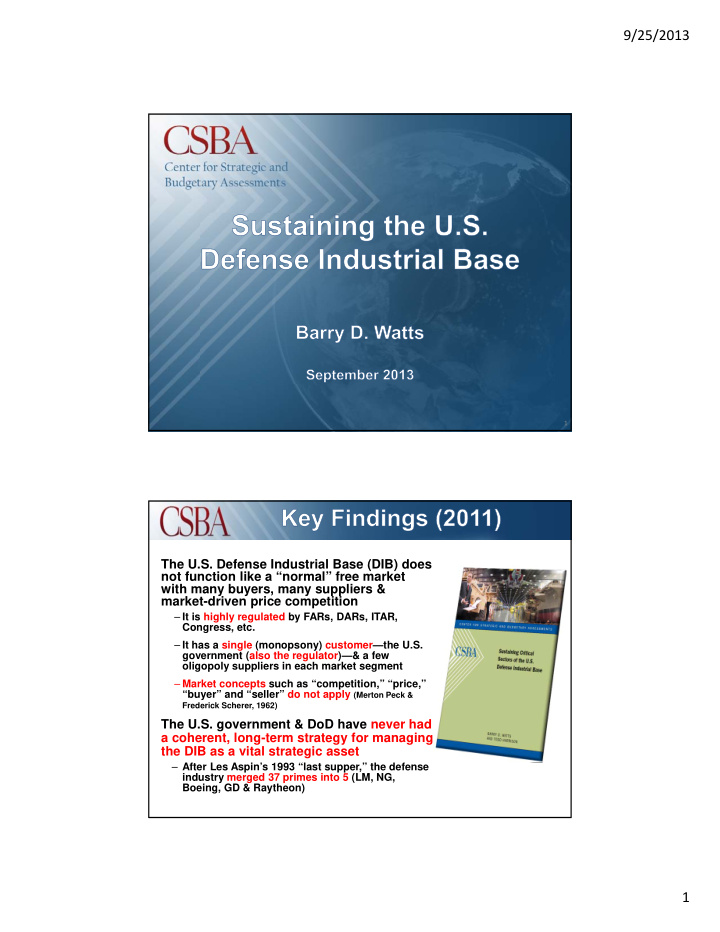



9/25/2013 1 The DIB Past, Present, Future (2008) Click to edit Master title style The U.S. Defense Industrial Base (DIB) does not function like a “normal” free market with many buyers, many suppliers & market-driven price competition – It is highly regulated by FARs, DARs, ITAR, Congress, etc. – It has a single (monopsony) customer—the U.S. government (also the regulator)—& a few oligopoly suppliers in each market segment – Market concepts such as “competition,” “price,” “buyer” and “seller” do not apply (Merton Peck & Frederick Scherer, 1962) The U.S. government & DoD have never had a coherent, long-term strategy for managing the DIB as a vital strategic asset – After Les Aspin’s 1993 “last supper,” the defense industry merged 37 primes into 5 (LM, NG, Boeing, GD & Raytheon) 1
9/25/2013 Because without a strategy you may lose critical capabilities • “If you allow a unique skill set to atrophy, it is a very costly and expensive process to recover it” (Karl Hasslinger) Consider the Royal Navy’s Astute -class SSN: • BAE Systems selected to build the new submarine in 1997 • The British did not have the needed design & production capabilities • Brought in GD Electric Boat (contracts totaling $53 million in 2003) • Costs: £1.8 billion cost overrun & HMS Astute 4 years late 3 A DIB strategy should first decide what to keep for the long haul rather starting with what to reduce or cut for the current budget cycle The alternative is to risk losing the DIB’s “crown jewels” to recurring bouts of short-term, across- the-board budget cutting 4 2
9/25/2013 • The DIB is a diverse array of companies, large & small, with many sectors & tiers (DASD/MIPB); also with growing global ties • DoD faces tightening fiscal constraints (OCO going away, sequestration, political gridlock, etc.) • DoD faces a growing array of current & emerging security challenges (jihadist extremists & insurgents, the “Arab spring,” Iran, China, Russia, etc.) • Can the concept of core competencies help to decide what to keep? • What is a core competency? 5 • Definition : A combination of technology, manufacturing base, skilled manpower, training, focus, adaptivity, & experience that enables an organization to accomplish something of strategic importance better than rivals (Cockell, Martin & Weaver, SAIC for OSD/NA) • Characteristics (C. K. Prahalad & Gary Hamel ): – Provides significant value to customers – Applicable across many “product lines” (or mission areas) – Difficult for rivals to replicate – Costly to recover if lost • Examples : – Honda: engines/powertrains & fast product cycle times (1980s) – Intel: Memory chips (until 1985); microprocessors (after 1985) – DoD: Long-range precision strike • The DIB’s core competencies should support DoD’s 6 3
9/25/2013 “Few companies are likely to build world leadership in more than 5 or 6 fundamental competencies. A company that compiles a list of 20 to 30 capabilities has probably not produced a list of core competencies.” — Prahalad & Hamel • A DIB strategy based on 20 or 30 “top priorities” isn’t strategy • Useful lists of DoD or DIB core competencies must be short—less than 10 1. Global non-nuclear precision strike 2. Flexible, effective nuclear forces 3. Capability to project & sustain combined- arms campaigns at the operational level of war 4. Access to & freedom of action in the global commons—at sea, in orbital space & in the electromagnetic spectrum (of which cyber is a part) 5. The cryptologic enterprise 6. Realistic combat training 8 4
9/25/2013 1. Precision weapons, including missiles for both strike & defense 2. Low-signature platforms such as stealthy air vehicles, both manned & unmanned, & nuclear submarines 3. Global ISR (reconnaissance satellites, GPS, UAVs, etc.) 4. Integrated battle networks that marry ISR with robust command, control & communications (C3) 5. The skills, procedures, tools & organizations for dominating the electromagnetic spectrum (including network attack, network defense & cryptologic skills) 6. Large-scale system & network-architecture integration 9 Not every element in the supply chains underlying a DIB core competency will demand special attention or preferential investment Deciding which elements do requires detailed mapping of the DIB (which only DoD can do) Industrially Critical & Fragile Niches 10 5
9/25/2013 Losing critical defense industrial capabilities 11 DIB DoD 1. Precision weapons, including missiles for both strike & defense 1. Global non-nuclear precision 2. Low-signature platforms such as strike stealthy air vehicles, both manned & 2. Flexible, effective nuclear forces unmanned, & nuclear submarines 3. Capability to project & sustain 3. Global ISR (reconnaissance combined-arms campaigns at the satellites, GPS, UAVs, etc.) operational level of war 4. Integrated battle networks that 4. Access to & freedom of action in marry ISR with robust command, the global commons—at sea, in control & communications (C3) orbital space & the in 5. The skills, procedures, tools & electromagnetic spectrum (of organizations for dominating the which cyber is a part) electromagnetic spectrum (including 5. The cryptologic enterprise network attack, network defense & cryptologic skills) 6. Realistic combat training 6. Large-scale system & network- architecture integration 12 6
Recommend
More recommend